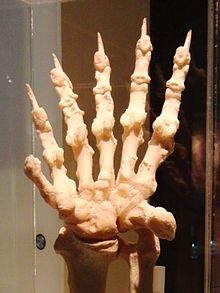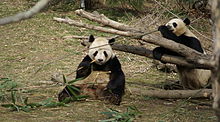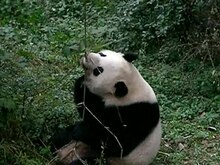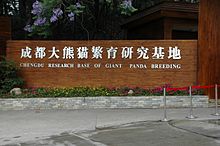From Wikipedia, the free encyclopedia
| Giant panda | |
|---|---|
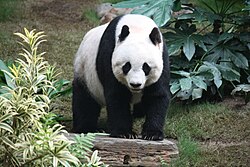 |
|
| Conservation status | |
| Scientific classification |
|
| Kingdom: | Animalia |
| Phylum: | Chordata |
| Class: | Mammalia |
| Order: | Carnivora |
| Family: | Ursidae |
| Genus: | Ailuropoda |
| Species: | A. melanoleuca |
| Binomial name | |
| Ailuropoda melanoleuca (David, 1869) |
|
| Subspecies | |
 |
|
| Giant panda range | |
The giant panda (Ailuropoda melanoleuca, lit. "black and white cat-foot"; simplified Chinese: 大熊猫; traditional Chinese: 大熊貓; pinyin: dà xióng māo, lit. "big bear cat"),[2] also known as panda bear or simply panda, is a bear[3] native to south central China.[1] It is easily recognized by the large, distinctive black patches around its eyes, over the ears, and across its round body. The name "giant panda" is sometimes used to distinguish it from the unrelated red panda. Though it belongs to the order Carnivora, the giant panda's diet is over 99% bamboo.[4] Giant pandas in the wild will occasionally eat other grasses, wild tubers, or even meat in the form of birds, rodents or carrion. In captivity, they may receive honey, eggs, fish, yams, shrub leaves, oranges, or bananas along with specially prepared food.[5][6]
The giant panda lives in a few mountain ranges in central China, mainly in Sichuan province, but also in neighbouring provinces, namely Shaanxi and Gansu.[7] As a result of farming, deforestation, and other development, the giant panda has been driven out of the lowland areas where it once lived.
The giant panda is a conservation reliant endangered species.[8] A 2007 report shows 239 pandas living in captivity inside China and another 27 outside the country.[9] As of December 2014, 49 giant pandas live in captivity outside China, living in 18 zoos in 13 different countries.[10] Wild population estimates vary; one estimate shows that there are about 1,590 individuals living in the wild,[9] while a 2006 study via DNA analysis estimated that this figure could be as high as 2,000 to 3,000.[11] Some reports also show that the number of giant pandas in the wild is on the rise.[12][13] On March 2015, Mongabay stated the wild giant panda population increased by 268, or 16.8%, totaling to 1,864 individuals.[14] However, the IUCN does not believe there is enough certainty yet to reclassify the species from Endangered to Vulnerable.[1]
While the dragon has often served as China's national emblem, internationally the giant panda appears at least as commonly. As such, it is becoming widely used within China in international contexts, for example as one of the five Fuwa mascots of the Beijing Olympics.
Description
The giant panda has a black-and-white coat. Adults measure around 1.2 to 1.9 m (4 to 6 ft) long, including a tail of about 10–15 cm (3.9–5.9 in), and 60 to 90 cm (2.0 to 3.0 ft) tall at the shoulder.[15][16] Males can weigh up to 160 kg (350 lb).[17] Females (generally 10–20% smaller than males)[18] can weigh as little as 70 kg (150 lb), but can also weigh up to 125 kg (276 lb).[8][15][19] Average adult weight is 100 to 115 kg (220 to 254 lb).[20]
The giant panda has a body shape typical of bears. It has black fur on its ears, eye patches, muzzle, legs, arms and shoulders. The rest of the animal's coat is white. Although scientists do not know why these unusual bears are black and white, speculation suggests that the bold coloring provides effective camouflage in their shade-dappled snowy and rocky habitat.[21] The giant panda's thick, wooly coat keeps it warm in the cool forests of its habitat.[21] The panda's skull shape is typical of durophagous carnivorans. It has evolved from previous ancestors to exhibit larger molars with increased complexity and expanded temporal fossa.[22][23] A 110.45 kg (243.5 lb) giant panda has a 3D canine teeth bite force of 2603.47 newtons and bite force quotient of 292.[24] Another study had a 117.5 kg (259 lb) giant panda bit 1298.9 newtons (BFQ 151.4) at canine teeth and 1815.9 newtons (BFQ 141.8) at carnassial teeth.[25]
The giant panda's paw has a "thumb" and five fingers; the "thumb" – actually a modified sesamoid bone – helps it to hold bamboo while eating.[26] Stephen Jay Gould discusses this feature in his book of essays on evolution and biology, The Panda's Thumb.
The giant panda's tail, measuring 10 to 15 cm (4 to 6 in), is the second-longest in the bear family. (The longest belongs to the sloth bear.)[18]
The giant panda typically lives around 20 years in the wild and up to 30 years in captivity.[27] The oldest captive, a female named Ming Ming, had a recorded age of 34.[28]
Behavior
The giant panda is a terrestrial animal and primarily spends its life roaming and feeding in the bamboo forests of the Qinling Mountains and in the hilly Sichuan Province.[29] Giant pandas are generally solitary,[30] and each adult has a defined territory, and a female is not tolerant of other females in her range. Pandas communicate through vocalization and scent marking such as clawing trees or spraying urine.[8] They are able to climb and take shelter in hollow trees or rock crevices, but do not establish permanent dens. For this reason, pandas do not hibernate, which is similar to other subtropical mammals, and will instead move to elevations with warmer temperatures.[31] Pandas rely primarily on spatial memory rather than visual memory.[32]Social encounters occur primarily during the brief breeding season in which pandas in proximity to one another will gather.[33] After mating, the male leaves the female alone to raise the cub.[34]
Though the panda is often assumed to be docile, it has been known to attack humans, presumably out of irritation rather than aggression.[35][36][37]
Diet
Despite its taxonomic classification as a carnivoran, the giant panda's diet is primarily herbivorous, consisting almost exclusively of bamboo.[27] However, the giant panda still has the digestive system of a carnivore, as well as carnivore-specific genes,[38] and thus derives little energy and little protein from consumption of bamboo. Its ability to digest cellulose is ascribed to the microbes in its gut.[39][40] Pandas are born with sterile intestines, and require bacteria obtained from their mother's feces to digest vegetation.[41][42] The giant panda is a "highly specialized" animal with "unique adaptations", and has lived in bamboo forests for millions of years.[30] The average giant panda eats as much as 9 to 14 kg (20 to 30 lb) of bamboo shoots a day to compensate for its low level of energy digestibility. Ingestion of such a large quantity of material is possible due to the rapid passage of large amounts of indigestible plant material through the short, straight digestive tract.[43][44] It is also noted, however, that such rapid passage of digesta limits the potential of microbial digestion in the gastrointestinal tract,[43] limiting alternative forms of digestion. Given this large diet, the giant panda defecates up to 40 times a day.[45] The limited energy input imposed on it by its diet has affected the panda's behavior. The giant panda tends to limit its social interactions and avoids steeply sloping terrain to limit its energy expenditures.[46]
Two of the panda's most distinctive features, its large size and round face, are adaptations to its bamboo diet. Anthropologist Russell Ciochon observed: “[much] like the vegetarian gorilla, the low body surface area to body volume [of the giant panda] is indicative of a lower metabolic rate. This lower metabolic rate and a more sedentary lifestyle allows the giant panda to subsist on nutrient poor resources such as bamboo.”[46] Similarly, the giant panda's round face is the result of powerful jaw muscles, which attach from the top of the head to the jaw.[46] Large molars crush and grind fibrous plant material.
The morphological characteristics of extinct relatives of the giant panda suggest that while the ancient giant panda was omnivorous 7 mya, it only became herbivorous some 2-2.4 mya with the emergence of A. microta.[47][48] Genome sequencing of the giant panda suggests that the dietary switch could have initiated from the loss of the sole T1R1/T1R3 umami taste receptor, resulting from two frameshift mutations within the T1R1 exons.[49] Umami taste corresponds to high levels of glutamate as found in meat, and may have thus altered the food choice of the giant panda.[50] Although the pseudegenization of the umami taste receptor in Ailuropoda coincides with the dietary switch to herbivory, it is likely a result of, and not the reason for, the dietary change.[48][51][52] The mutation time for the T1R1 gene in the giant panda is estimated to 4.2 mya[48] while fossil evidence indicates bamboo consumption in the giant panda species at least 7 mya,[47] signifying that although complete herbivory occurred around 2 mya, the dietary switch was initiated prior to T1R1 loss-of-function.
Pandas eat any of 25 bamboo species in the wild, such as Fargesia dracocephala[53] and Fargesia rufa.[54] Only a few bamboo species are widespread at the high altitudes pandas now inhabit. Bamboo leaves contain the highest protein levels; stems have less.[55]
Because of the synchronous flowering, death, and regeneration of all bamboo within a species, the giant panda must have at least two different species available in its range to avoid starvation. While primarily herbivorous, the giant panda still retains decidedly ursine teeth, and will eat meat, fish, and eggs when available. In captivity, zoos typically maintain the giant panda's bamboo diet, though some will provide specially formulated biscuits or other dietary supplements.[56]
Pandas will travel between different habitats if they need to, so they can get the nutrients that they need and to balance their diet for reproduction. For six years, scientists studied six pandas tagged with GPS collars at the Foping Reserve in the Qinling Mountains. They took note of their foraging and mating habits, and analysed samples of their food and feces. The pandas would move from the valleys in to the Qinling Mountains and would only return to the valleys in Autumn. During the summer months bamboo shoots rich in protein are only available at higher altitudes which causes low calcium rates in the pandas and during breeding season the pandas would trek back down to eat bamboo leaves rich in calcium. [57]
Genomics
The giant panda genome was sequenced in 2009 using Illumina dye sequencing.[58] Its genome contains 20 pairs of autosomes and one pair of sex chromosomes.Classification
For many decades, the precise taxonomic classification of the giant panda was under debate because it shares characteristics with both bears and raccoons.[59] However, molecular studies suggest the giant panda is a true bear and part of the family Ursidae,[3][60] though it differentiated early in history from the main ursine stock. The giant panda's closest extant relative is the spectacled bear of South America.[61] The giant panda has been referred to as a living fossil.[62]Despite the shared name, habitat type, and diet, as well as a unique enlarged bone called the pseudo thumb (which helps them grip the bamboo shoots they eat) the giant panda and red panda are only distantly related. Molecular studies have placed the red panda in its own family Ailuridae, and not under Ursidae.
Subspecies
Two subspecies of giant panda have been recognized on the basis of distinct cranial measurements, color patterns, and population genetics (Wan et al., 2005).- The nominate subspecies Ailuropoda melanoleuca consists of most extant populations of panda. These animals are principally found in Sichuan and display the typical stark black and white contrasting colors.
- The Qinling panda, A. m. qinlingensis[63] is restricted to the Qinling Mountains in Shaanxi at elevations of 1300–3000 m. The typical black and white pattern of Sichuan giant pandas is replaced with a dark brown versus light brown pattern. The skull of A. m. qinlingensis is smaller than its relatives, and it has larger molars.
Uses and human interaction
Early references
In the past, pandas were thought to be rare and noble creatures – the Empress Dowager Bo was buried with a panda skull in her vault. The grandson of Emperor Taizong of Tang is said to have given Japan two pandas and a sheet of panda skin as a sign of goodwill. Unlike many other animals in Ancient China, pandas were rarely thought to have medical uses. The few known uses include the Sichuan tribal peoples' use of panda urine to melt accidentally swallowed needles, and the use of panda pelts to control menses as described in the Qin Dynasty encyclopedia Erya.[66]The creature named mo (貘) mentioned in some ancient books has been interpreted as giant panda.[66] The dictionary Shuowen Jiezi (Eastern Han Dynasty) says that the mo, from Shu (Sichuan), is bear-like, but yellow-and-black,[67] although the older Erya describes mo simply as a "white leopard".[68] The interpretation of the legendary fierce creature pixiu (貔貅) as referring to the giant panda is also common.[69]
During the reign of the Yongle Emperor (early 15th century), his relative from Kaifeng sent him a captured zouyu (騶虞), and another zouyu was sighted in Shandong. Zouyu is a legendary "righteous" animal, which, similarly to a qilin, only appears during the rule of a benevolent and sincere monarch. It is said to be fierce as a tiger, but gentle and strictly vegetarian, and described in some books as a white tiger with black spots. Puzzled about the real zoological identity of the creature captured during the Yongle era, J.J.L. Duyvendak exclaims, "Can it possibly have been a Pandah?"[70]
The comparative obscurity of the giant panda throughout most of China's history is illustrated by the fact that, despite there being a number of depictions of bears in Chinese art starting from its most ancient times, and the bamboo being one of the favorite subjects for Chinese painters, there are no known pre-20th-century artistic representations of giant pandas.
Western discovery
The West first learned of the giant panda on 11 March 1869, when the French missionary Armand David[59] received a skin from a hunter. The first Westerner known to have seen a living giant panda is the German zoologist Hugo Weigold, who purchased a cub in 1916. Kermit and Theodore Roosevelt, Jr., became the first Westerners to shoot a panda, on an expedition funded by the Field Museum of Natural History in the 1920s. In 1936, Ruth Harkness became the first Westerner to bring back a live giant panda, a cub named Su Lin[71] which went to live at the Brookfield Zoo in Chicago. In 1938, five giant pandas were sent to London.[72][73] Activities such as these were halted because of wars; for the next half of the century, the West knew little of giant pandas.Panda diplomacy
Loans of giant pandas to American and Japanese zoos formed an important part of the diplomacy of the People's Republic of China (PRC) in the 1970s, as it marked some of the first cultural exchanges between the PRC and the West. This practice has been termed "Panda diplomacy".By 1984, however, pandas were no longer given as gifts. Instead, the PRC began to offer pandas to other nations only on 10-year loans, under terms including a fee of up to US$1,000,000 per year and a provision that any cubs born during the loan are the property of the PRC. Since 1998, because of a WWF lawsuit, the United States Fish and Wildlife Service allows a US zoo to import a panda only if the zoo can ensure the PRC will channel more than half of its loan fee into conservation efforts for the giant panda and its habitat.
In May 2005, the PRC offered a breeding pair to Taiwan. The issue became embroiled in cross-Strait relations – both over the underlying symbolism, and over technical issues such as whether the transfer would be considered "domestic" or "international", or whether any true conservation purpose would be served by the exchange.[74] A contest in 2006 to name the pandas was held in the mainland, resulting in the politically charged names Tuan Tuan and Yuan Yuan (from tuanyuan, meaning "reunion", i.e. "reunification"). PRC's offer was initially rejected by President Chen of Taiwan. However, when Ma Ying-jeou assumed the presidency in 2008, the offer was accepted, and the pandas arrived in December of that year.[75]
Biofuel
Microbes in panda waste are being investigated for their use in creating biofuels from bamboo and other plant materials.[76]Conservation
The giant panda is an endangered species, threatened by continued habitat loss and by a very low birthrate, both in the wild and in captivity.[27] Its range is currently confined to a small portion on the western edge of its historical range, which stretched through southern and eastern China, northern Myanmar, and northern Vietnam.[1]The giant panda has been a target of poaching by locals since ancient times and by foreigners since it was introduced to the West. Starting in the 1930s, foreigners were unable to poach giant pandas in China because of the Second Sino-Japanese War and the Chinese Civil War, but pandas remained a source of soft furs for the locals. The population boom in China after 1949 created stress on the pandas' habitat, and the subsequent famines led to the increased hunting of wildlife, including pandas. During the Cultural Revolution, all studies and conservation activities on the pandas were stopped. After the Chinese economic reform, demand for panda skins from Hong Kong and Japan led to illegal poaching for the black market, acts generally ignored by the local officials at the time.
Though the Wolong National Nature Reserve was set up by the PRC government in 1958 to save the declining panda population, few advances in the conservation of pandas were made, owing to inexperience and insufficient knowledge of ecology. Many believed the best way to save the pandas was to cage them. As a result, pandas were caged at any sign of decline, and suffered from terrible conditions. Because of pollution and destruction of their natural habitat, along with segregation caused by caging, reproduction of wild pandas was severely limited. In the 1990s, however, several laws (including gun control and the removal of resident humans from the reserves) helped their chances of survival. With these renewed efforts and improved conservation methods, wild pandas have started to increase in numbers in some areas, though they still are classified as a rare species.
In 2006, scientists reported that the number of pandas living in the wild may have been underestimated at about 1,000. Previous population surveys had used conventional methods to estimate the size of the wild panda population, but using a new method that analyzes DNA from panda droppings, scientists believe the wild population may be as large as 3,000.[27] Although the species is still endangered, the conservation efforts are thought to be working. In 2006, there were 40 panda reserves in China, compared to just 13 reserves two decades ago.[11]
The giant panda is among the world's most adored and protected rare animals, and is one of the few in the world whose natural inhabitant status was able to gain a UNESCO World Heritage Site designation. The Sichuan Giant Panda Sanctuaries, located in the southwest Sichuan province and covering seven natural reserves, were inscribed onto the World Heritage List in 2006.[77][78]
Not all conservationists agree that the money spent on conserving pandas is well spent. Chris Packham has argued that the breeding of pandas in captivity is "pointless" because "there is not enough habitat left to sustain them".[79] Packham argues that the money spent on pandas would be better spent elsewhere,[79] and has said he would "eat the last panda if I could have all the money we have spent on panda conservation put back on the table for me to do more sensible things with,"[80] though he has apologized for upsetting people who like pandas.[81] He points out, "The panda is possibly one of the grossest wastes of conservation money in the last half century."[80]
In 2012, Earthwatch Institute, a global nonprofit that teams volunteers with scientists to conduct important environmental research, launched a program called "On the Trail of Giant Panda". This program, based in the Wolong National Nature Reserve, allows volunteers to work up close with pandas cared for in captivity, and help them adapt to life in the wild, so that they may breed, and live longer and healthier lives.[82]
Reproduction

A giant panda cub. At birth, the giant panda typically weighs 100 to 200 grams (3 1⁄2 to 7 oz) and measures 15 to 17 centimeters (6 to 7 in) long.[83]
Initially, the primary method of breeding giant pandas in captivity was by artificial insemination, as they seemed to lose their interest in mating once they were captured.[84] This led some scientists to try extreme methods, such as showing them videos of giant pandas mating[85] and giving the males Viagra.[86] Only recently have researchers started having success with captive breeding programs, and they have now determined giant pandas have comparable breeding to some populations of the American black bear, a thriving bear family. The current reproductive rate is considered one young every two years.[13][29] The giant panda produces the proportionally smallest baby of any placental mammal.[87]
Giant pandas reach sexual maturity between the ages of four and eight, and may be reproductive until age 20.[88] The mating season is between March and May, when a female goes into estrus, which lasts for two or three days and only occurs once a year.[89] When mating, the female is in a crouching, head-down position as the male mounts her from behind. Copulation time is short, ranging from 30 seconds to five minutes, but the male may mount her repeatedly to ensure successful fertilization. The gestation period ranges from 95 to 160 days.[89]
If twins are born, usually only one survives in the wild. The mother will select the stronger of the cubs, and the weaker will die. The mother is thought to be unable to produce enough milk for two cubs, since she does not store fat.[90] The father has no part in helping raise the cub.
When the cub is first born, it is pink, blind, and toothless,[91] weighing only 90 to 130 grams (3.2 to 4.6 ounces), or about 1/800th of the mother's weight.[59] It nurses from its mother's breast six to 14 times a day for up to 30 minutes at a time. For three to four hours, the mother may leave the den to feed, which leaves the cub defenseless. One to two weeks after birth, the cub's skin turns gray where its hair will eventually become black. A slight pink color may appear on cub's fur, as a result of a chemical reaction between the fur and its mother's saliva. A month after birth, the color pattern of the cub's fur is fully developed. Its fur is very soft and coarsens with age. The cub begins to crawl at 75 to 80 days;[59] mothers play with their cubs by rolling and wrestling with them. The cubs can eat small quantities of bamboo after six months,[92] though mother's milk remains the primary food source for most of the first year. Giant panda cubs weigh 45 kg (100 pounds) at one year, and live with their mothers until they are 18 months to two years old. The interval between births in the wild is generally two years.
In July 2009, Chinese scientists confirmed the birth of the first cub to be successfully conceived through artificial insemination using frozen sperm.[93] The cub was born at 07:41 on 23 July that year in Sichuan as the third cub of You You, an 11-year-old.[93][94][95] The technique for freezing the sperm in liquid nitrogen was first developed in 1980 and the first birth was hailed as a solution to the problem of lessening giant panda semen availability, which had led to inbreeding.[95][96] Panda semen, which can be frozen for decades, could be shared between different zoos to save the species.[93][94] It is expected that zoos in destinations such as San Diego in the United States and Mexico City will now be able to provide their own semen to inseminate more giant pandas.[96] In August 2014, a rare birth of panda triplets was announced in China; it was the fourth of such births ever reported.[97]
Attempts have also been made to reproduce giant pandas by interspecific pregnancy by implanting cloned panda embryos into the uterus of an animal of another species. This has resulted in panda foetuses, but no live births.[98]
Name
No conclusive explanation of the origin of the word "panda" has been found. The closest candidate is the Nepali word ponya, possibly referring to the adapted wrist bone. The Western world originally applied this name to the red panda. Until 1901, when it was erroneously stated to be related to the red panda, the giant panda was known as "mottled bear" (Ailuropus melanoleucus) or "particolored bear".[99]In most encyclopedic sources, the name "panda" or "common panda" originally referred to the lesser-known red panda,[100] thus necessitating the inclusion of "giant" and "lesser/red" prefixes in front of the names. Even in 2010, the Encyclopædia Britannica still used "giant panda" or "panda bear" for the bear,[101] and simply "panda" for the Ailuridae,[102] despite the popular usage of the word "panda".
Since the earliest collection of Chinese writings, the Chinese language has given the bear 20 different names, such as huāxióng (花熊 "spotted bear") and zhúxióng (竹熊 "bamboo bear").[103] The most popular names in China today are dàxióngmāo (大熊貓 literally "large bear cat"), or just xióngmāo (熊貓 "bear cat"). The name may have been inspired by the giant panda's eyes, which have cat-like vertical slits – unlike other bear species, which have round pupils.[104]
In Taiwan, the popular name for panda is the inverted māoxióng (貓熊 "cat bear"), though many encyclopedia and dictionaries in Taiwan still use the "bear cat" form as the correct name. Some linguists argue, in this construction, "bear" instead of "cat" is the base noun, making this name more grammatically and logically correct, which may have led to the popular choice despite official writings.[103]
In zoos
Pandas have been kept in zoos as early as the Western Han Dynasty in China, where the writer Sima Xiangru noted that the panda was the most treasured animal in the emperor's garden of exotic animals in the capital Chang'an (present Xi'an). Not until the 1950s were pandas again recorded to have been exhibited in China's zoos.[105]Chi Chi at the London Zoo became very popular. This influenced the World Wildlife Fund to use a panda as its symbol.[106]
A 2006 New York Times article[107] outlined the economics of keeping pandas, which costs five times more than that of the next most expensive animal, an elephant. American zoos generally pay the Chinese government $1 million a year in fees, as part of a typical ten-year contract. San Diego's contract with China was to expire in 2008, but got a five-year extension at about half of the previous yearly cost.[108] The last contract, with the Memphis Zoo in Memphis, Tennessee, ends in 2013.[107]
Asia
- China
Many zoos and breeding centers in China house giant pandas. These include:
- Beijing Zoo – home of the internationally notorious Gu Gu and Ming-Ming first panda born in captivity
- Shanghai Zoo
- Bifengxia Panda Base, Ya'an, Sichuan, is home to US-born giant pandas Mei Sheng (M), Hua Mei (F), Tai Shan (M),[109] Su Lin (F),[110] and Zhen Zhen (F).[110] It is also home to the Austrian-born Fu Long.[111]
- Chengdu Research Base of Giant Panda Breeding, Chengdu, Sichuan – Twelve cubs were born here in 2006.[112] It is also home to Japanese-born Xiong Bang (M)[113] and US-born Mei Lan (F).[114]
- China Conservation and Research Center for the Giant Panda at the Wolong National Nature Reserve, Sichuan – Seventeen cubs were born here in 2006.[112]
- Chime-Long Paradise Amusement Park, in Guangzhou, where three very rare panda triplets were born (all three have thus far survived) in July 2014
- Ocean Park, Hong Kong – home to Jia Jia (F), An An (M), Le Le (M), and Ying Ying (F)[115]
- Macau Giant Panda Pavilion – home to Kai Kai (M) and Xin Xin (M) of Chengdu origin[116]
- Dalian Forest Zoo – home to Fei Yun (F), Cai Zhen (F) and Jin Hu (M) of Wolong origin[117]
- Other places in Asia
- Taipei Zoo, Taipei, Taiwan – home to Tuan Tuan (M) and Yuan Yuan (F), and their offspring Yuan Zai (F).[118]
- Chiang Mai Zoo, Chiang Mai, Thailand – home to Chuang Chuang (M), Lin Hui (F), and Lin Bing, a female cub born 27 May 2009.[119][120]
- Adventure World, Shirahama, Wakayama, Japan – Until recently, it was home to Ei Mei (M), Mei Mei (F), Rau Hin (F), Ryu Hin and Syu Hin (M twins), and Kou Hin (M). In December 2006, twin cubs were born to Ei Mei and Mei Mei. Two cubs, Eiihin (M) and Meihin (F), were born to Rau Hin on 13 September 2008.[121][122] Mei Mei, a mother of ten cubs, died on 15 October 2008.[123][124]
- Oji Zoo, Kobe, Hyōgo, Japan – home of Kou Kou (M), Tan Tan (F)[125]
- River Safari, a new park under Wildlife Reserves Singapore. Singapore received two pandas (Kai Kai and Jia Jia) in 2012.[126]
- Zoo Negara, Kuala Lumpur, Malaysia – home to Fu Wa (M), and Feng Yi (F).[127]
Australia
- Adelaide Zoo, is home to Wang Wang (M) and Funi (F). They arrived on 28 November 2009, and went on display on 14 December. They are expected to stay for a minimum of 10 years, and are the only giant pandas living in the Southern Hemisphere.[128]
Europe
- Berlin Zoological Garden, Germany is the former home of Bao Bao, which died in 2012 at the age of 34.[129][130] He was the oldest male panda living in captivity at the time of his death and had lived in Berlin for twenty five years. He never reproduced.
- Tiergarten Schönbrunn, Vienna, Austria – home to Yang Yang (F) and Long Hui (M), born in Wolong, China in 2000 They gave birth to Fu Long (M) in 2007,[131] and Fu Hu (M) in 2010.[132] Fu Long, who has been relocated to China, was the first to be born in Europe in 25 years.[131]
- Zoo Aquarium, Madrid, Spain is the home of Bing Xing (M) and Hua Zuiba (F) since 2007. They gave birth to twin cubs on 7 September 2010.[133] The zoo was also the site of the first giant panda birth in Europe, in 1982.[134] That giant panda cub was named Chu-lin.[134]
- The Edinburgh Zoo, Scotland – home to Tian Tian (F) and Yang Guang (M) since 4 December 2011.[135]
- ZooParc de Beauval, Saint-Aignan, Loir-et-Cher, France – home to Huan Huan (F) and Yuan Zi (M) since 15 January 2012.[136]
- Pairi Daiza, Cambron-Casteau, Belgium - home to Hao Hao (F) and Xing Hui (M) since February 2014
North America
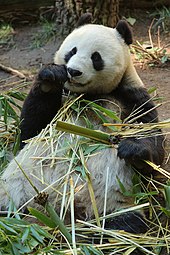
Bai Yun, at San Diego Zoo, has given birth to 5 cubs in captivity and is considered one of the most successfully reproductive captive pandas.
- Chapultepec Zoo, Mexico City – home of Xiu Hua, born on 25 June 1985, Shuan Shuan, born on 15 June 1987, and Xin Xin, born on 1 July 1990 from Tohui (Tohui born on Chapultepec Zoo on 21 July 1981 and died on 16 November 1993), all females[137][138]
- San Diego Zoo, San Diego – home of Bai Yun (F), Gao Gao (M), Yun Zi (M), and Xiao Liwu (M)[139]
- National Zoo in Washington, DC – home of Mei Xiang (F) and Tian Tian (M),[140] and a female cub, now named Bao Bao, born to Mei Xiang on August 23, 2013.[141]
- Zoo Atlanta, Atlanta – home of Lun Lun (F), Yang Yang (M), Xi Lan (M), and Po (F),[142] born 3 November 2010[143] and twin female[142] cubs born 15 July 2013[144]
- Memphis Zoo, Memphis – home of Ya Ya (F) and Le Le (M)[145]
- The Toronto Zoo and Calgary Zoo are hosting a pair of pandas named Er Shun (F) and Da Mao (M). The two pandas arrived in Canada at the Toronto Zoo in March 2013 (two months before the exhibit opened in May), and will spend 10 years in Canada, evenly split between Toronto and Calgary.[146][147][148] For Toronto this will be the second set of pandas, in 1985 Quan Quan (Female, died 2010 at Jinan Zoo at age 21) and Qing Qing (Female born Sept 9, 1984 and later at Wuhan Zoo and now at Chengdu Panda Base[149]) were sent to the zoo for 100 days beginning in July.[150]
North American-born pandas
- Tohui (Tarahumara word for child), born 21 July 1981, died 16 November 1993, a female at Chapultepec Zoo, Mexico City, was the first giant panda to be born and survive in captivity outside China. Her parents were Ying Ying and Pe Pe.[151]
- Hua Mei, was born 1999 in the San Diego Zoo and sent to China in 2004.[139]
- Mei Sheng, born 2003 at the San Diego Zoo, sent to China 2007.[139]
- Tai Shan, born 9 July 2005 at the National Zoo in Washington, DC,[152] was sent to China in 2010.
- Su Lin was born 2 August 2005 at the San Diego Zoo and moved to China in 2010.[139]
- Mei Lan, born 6 September 2006 at Zoo Atlanta, was sent to China in 2010.
- Zhen Zhen, born 3 August 2007 at the San Diego Zoo, was moved to China in 2010.[139]
- Xi Lan, born 30 August 2008 at Zoo Atlanta[143]
- Yun Zi, born 5 August 2009 at the San Diego Zoo[139]
- Po, born 3 November 2010 at Zoo Atlanta[143]
- Xiao Liwu, born 29 July 2012 at the San Diego Zoo[139]
- Bao Bao, born 23 August 2013 at the National Zoo in Washington, DC.[153]

